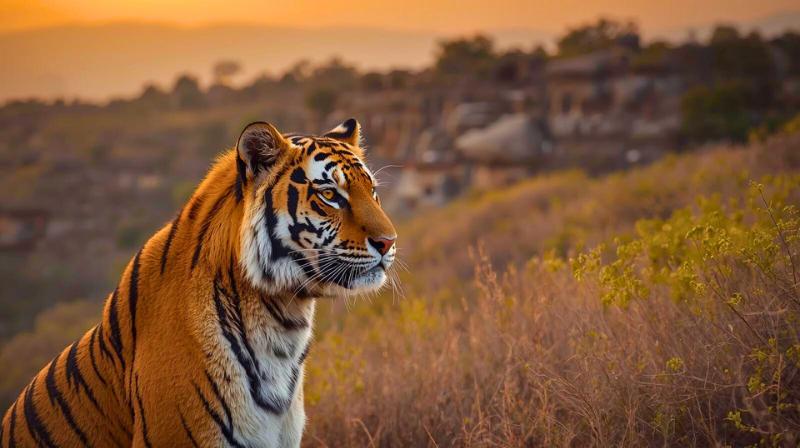Ranthambore Safari Guide: Tracking Tigers in India’s Wild Heart
September 20, 2025

Tracking Tigers in India's Wild Heart with the Ranthambore Safari Guide
One of India's most captivating wilderness areas is located in the center of Rajasthan, where the Aravalli and Vindhya ranges converge to form rocky cliffs and arid woods. This area is known as Ranthambore Tour Packages. The name evokes visions of elusive Bengal tigers stealthily gliding through long grass, peacocks echoing across ancient ruins, and the excitement of a safari that combines pilgrimage with adventure for tourists from all over the world. Seeing wildlife is only one aspect of the Ranthambore Safari Guide another is exploring a setting where nature, myth, and history all coexist in striking harmony.
There is more to Ranthambore than just a tiger reserve. Folklore, dynasties, and centuries of conflict are all shown on this canvas. Every visitor is reminded that this wilderness once reverberated with the clash of armies and the prayers of monarchs by the imposing Ranthambore Fort, a UNESCO World Heritage Site, which rises at its center. Lakes glisten around its ramparts, crocodiles lounge in the sun, and herds of deer move elegantly. These days, tourists arrive as awe-seekers rather than conquerors, hoping for that once-in-a-lifetime sight of a tiger's amber eyes peeking out from the forest.
The Tigers of Ranthambore: Their Allure
The tigers are the most distinctive animal in Ranthambore. The Bengal tiger, regarded as the most gregarious of large cats, is a symbol of both fierceness and grandeur. In addition to being predators, tigers in Ranthambore are also mythical creatures with names, personalities, and tales that permeate safari culture.
The fabled tigress Machli, often known as the "Queen of Ranthambore," is still remembered by tourists. She raised several litters and protected her territory well into old age, ruling the park for many years. Naturalists described her ferocious conflicts with crocodiles, her fortitude following the loss of her canines, and her capacity for graceful adaptation. When tourists encountered her in the wild, they frequently talked about feeling a connection that was indescribable and realizing they were with royalty.
Her descendants wander the park today. Forest rangers and guides keep note of each tiger's identify. T-19, T-39, T-57—numbers that, to those who track their movements, soon take on identities and personalities. Stories of encounters are shared by travelers: a male tiger roaring across the valley, trembling the air with primeval authority; a tigress strolling placidly next to a safari van at dawn; a tiny cub learning to pursue spotted deer. These are experiences that leave a lasting impression on memory, not merely sightings of nature.
The Scenery: A Wilderness Theater
The landscape of Ranthambore is perhaps as appealing as its tigers. The park includes a mosaic of habitats spanning over 1,300 square kilometers of protected land, including core and buffer zones. Open meadows, craggy escarpments, and placid lakes are scattered throughout the mostly dry deciduous woodlands. Every safari drive is different due to the shifting landscape; one area may open up to a lake full of birds, another to a meadow where sambar deer graze, and still another to sheer cliffs where leopards silently observe from above.
From several safari paths, the fort, which rises above the woodland, is a permanent presence. Its stepwells, temples, and old walls provide a setting where the past and the present coexist. Its base is surrounded by the shimmering Padam Talao and Rajbagh Talao, whose waters are often visited by kingfishers, herons, and sometimes tigers that come to cool down in the daytime heat.
The appeal of Ranthambore, according to many visitors, is that you never know what to anticipate. You might observe a family of langurs grooming one another on a banyan tree, hear chital deer warning of an impending predator, or see a serpent eagle flying across the sky, even if you don't see a tiger. Safaris are addictive because of the tension at every turn on the route.
Tales from the Fort: The Breath of History
The Ranthambore Fort is a character in the park's narrative, not only a setting. It was built at least as early as the 10th century and rises more than 700 feet above the plains. From the Chauhans to the Mughals, it has seen the rise and fall of dynasties. Here, sieges lasted, battles took place, and legends were created.
Travelers who ascend the stone steps of the fort frequently describe the eerie quiet, which is only disturbed by the rustle of wind through abandoned palaces and the screams of peacocks. The fort's temples, particularly the Ganesha Temple, are still in use, and pilgrims frequently visit bringing flowers and sweets as offerings. On other days, the fort is crowded with worshippers, whose vibrant clothing stands out against the worn stone, serving as a reminder that this desert is still a vibrant center of culture and religion.
The fort serves as a striking background that frames the forest for safarikers. A tiger strolling against the shadow of old walls is a scene that may be from any century, a timeless interaction that unites nature and history in one picture.
Safari Experience: The Excitation of Pursuit
Safaris are what make Ranthambore what it is. The park is separated into areas, each of which offers a unique landscape and seeing potential. The open 20-seater canter and the more compact, private gypsy jeep that can accommodate six persons are the two primary vehicle types used for safaris. Both have benefits: jeeps provide greater mobility and a stronger connection with the guide and driver, while canters provide a group experience with shared joy.
Travelers assemble at the gates before sunrise, the weather chilly and anticipation strong, and the excitement of a safari begins. To create tension, guides frequently whisper about the most recent sightings. The scene gradually comes to life as the car enters the woodland; sunlight peeks through the branches, birds sing from the tops of the trees, and deer quietly graze. Then comes the dramatic moment: the langur's cry, the forest's abrupt silence, and the guide's low voice: "tiger."
Many people have a life-changing experience when they first see a tiger. The animal's confident stride down its ancient path, the flare of orange and black in the foliage, the unhurried glance that recognizes but does not fear human presence. Despite the frantic clicking of cameras, tourists frequently put them down when they realize that no lens can adequately capture the intensity of the moment.
The trip is rewarding even if there are no tiger sightings. A diverse array of encounters is woven together by hyenas, sloth bears, jackals, leopards, and innumerable birds. From the majestic crested serpent eagle to the little paradise flycatcher with its flowing tail, the park is home to more than 300 different species of birds. Every safari has gems for wildlife lovers and photographers.
Folklore and Legends in the Jungle
Ranthambore is rich in myth and tradition, just like any other ancient terrain. Stories of tigers guarding temples, leopards that transform into spirits after death, and conflicts in which kings invoked the forest gods for victory are all told by the local villagers. Stories about tigers making friends with saints or ghosts prowling the ruins at night are examples of stories that combine fact and fiction.
These tales, which are told by safari guides, give the trip additional depth. They remind visitors that Ranthambore is a cultural environment where wilderness and human imagination have always coexisted, in addition to being a protected reserve. Driving by deteriorating watchtowers and banyan trees while listening to these legends is a way to connect with the centuries of storytelling that have preserved the park's memory.
Reviews and Views of Travelers
Another aspect of this Ranthambore Safari Guide is the voices of the tourists. A childhood dream comes true for some people when they go on their first safari. When they hear a tiger scream reverberating down the valley, they talk of getting goosebumps. Others talk about how peaceful it is to sit by a lake and observe crocodiles lounging and deer drinking warily, understanding that the drama of the jungle is present in every action, not just the tiger's outward look.
A lot of reviews highlight Ranthambore's unpredictable nature. There are no assurances, unlike at a zoo. Because of the scenery, the mood, and the feeling of being a part of something wild and untamed, some safaris come to a close without any tiger sightings, yet tourists still say they are unforgettable. Others remember safaris when tigers suddenly materialized and approached the car so closely that they could hear the grass rustling beneath the tiger's paws.
"I went to Ranthambore expecting to tick a tiger off my list," one traveler wrote. The way the light shone on the ruins, the way the deer raised their heads in alert, the way stillness sometimes seem louder than sound—all of these things gave me a sense of connectedness to the forest itself. The forest was the heart, but the tiger was the high point.
Conservation and Difficulties
The tigers of Ranthambore were once in danger of going extinct. There were only a few left in the 1970s. The population recovered with the aid of Project Tiger, which was started in 1973, and subsequent conservation efforts. With a robust and expanding population, Ranthambore is now regarded as one of the greatest locations on Earth to witness tigers in the wild.
However, issues like poaching, conflicts between people and wildlife, and pressure from tourists still exist. By supporting local communities, according to park regulations, and keeping in mind that the forest is primarily a sanctuary for its wild inhabitants, guides frequently remind tourists that every responsible traveler helps to conserve the environment.
Today, the park serves as a warning as well as a success story. Although its tigers stand for tenacity, their continued existence requires unwavering attention to detail. After experiencing the enchantment of Ranthambore, visitors return with more than just memories—they also have a greater appreciation for the importance of preserving such delicate ecosystems. For more information on exploring wildlife in Rajasthan, check out our Ranthambore National Park
